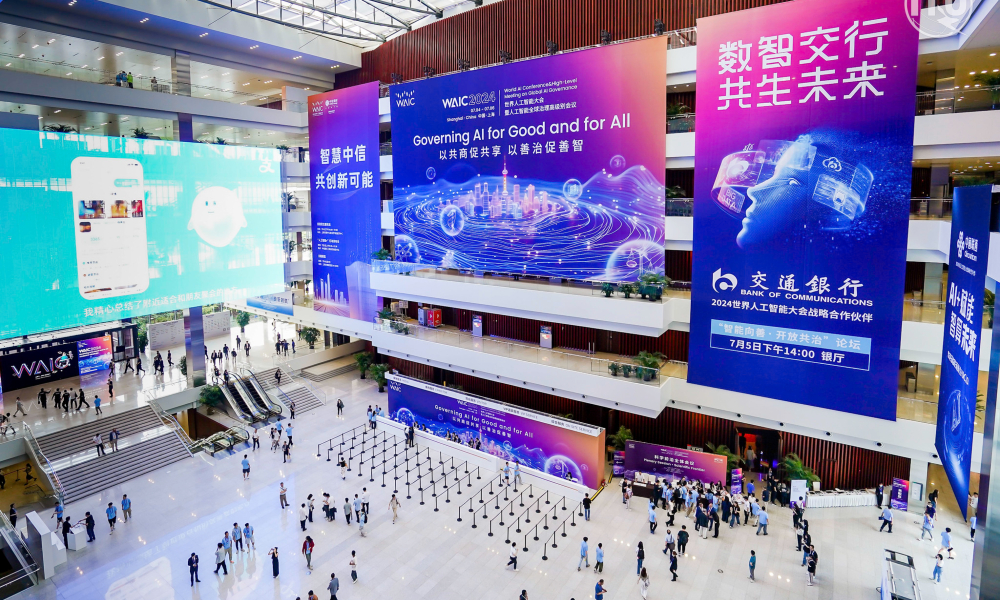Beyond DeepSeek: How China’s AI Ecosystem Fuels Breakthroughs

Published by The Lawfare Institute
in Cooperation With

Editor’s Note: The DeepSeek breakthrough shook U.S. confidence in its AI leadership as well as U.S. markets. Center for a New American Security’s Ruby Scanlon argues that the DeepSeek breakthrough is not simply the case of one company unexpectedly excelling. Rather, it reflects China’s deep investment in AI and successful effort to combine government support and private incentives.
Daniel Byman
***
In mid-January, leading U.S. artificial intelligence (AI) companies were sent reeling. DeepSeek, a Chinese AI company, unveiled its R1 model, a new chatbot of comparable quality to OpenAI’s GPT-4. While many analysts rushed to scrutinize DeepSeek’s technical capabilities, a more fundamental question loomed: How did a Chinese lab achieve such an impressive feat?
The answer lies not just in DeepSeek’s top engineers or innovative training techniques, but in the vast political and financial ecosystem China has built to accelerate AI innovation. Over the past decade, the Chinese government has made AI development a national priority, directing considerable sums of money, policy incentives, and public-private partnership opportunities toward ensuring that Beijing can compete—and ultimately lead—in AI.
A recent investigation by Radio Free Asia has revealed that DeepSeek is closely tied to the Chinese Communist Party, benefiting from the state’s full-throttle push for AI leadership. However, DeepSeek’s parent company, High-Flyer, began not as an AI laboratory but as a quantitative hedge fund using AI for stock trading. Beijing’s 2021 crackdown on speculative investments forced High-Flyer to pivot. Seeking to align with government priorities, High-Flyer transitioned to AI research—giving rise to DeepSeek.
By December 2023, DeepSeek had been designated a “national high-tech enterprise,” or HTNE, by Zhejiang provincial authorities. The coveted status, awarded by China’s Ministry of Science and Technology, grants preferential tax treatment, government subsidies, and research grants. These tools demonstrate Beijing’s commitment to fostering homegrown AI. The company’s political significance was cemented in early 2024 when DeepSeek’s co-founder, Liang Wenfeng, was invited to offer “opinions and suggestions” to Chinese Premier Li Qiang in Beijing. This official recognition of DeepSeek’s expertise made clear that China sees DeepSeek as not just another AI lab but as a champion of its technological ambitions.
The Chinese Communist Party has long viewed AI as central to national power. In 2017, China’s State Council released its Artificial Intelligence Development Plan, outlining its ambition to build a 1 trillion yuan AI-powered economy by 2030 and make AI the “main driving force” of industrial transformation. To achieve these goals, China adopted a multipronged strategy, increasing public investment in AI research, encouraging local governments to compete to attract AI talent and businesses, and steering private-sector development through public-private partnerships and government contracts.
Just three days after DeepSeek’s R1 release, the Bank of China also unveiled its AI Industry Development Action Plan, pledging 1 trillion yuan, or $137 billion, over the next five years to strengthen the AI supply chain. This investment aims to ensure China has the data and computing power needed to achieve “self-reliance in science and technology.”
Securing domestic computing infrastructure has become an urgent priority for the Chinese government as U.S. export controls have restricted China’s access to advanced AI chips, causing a nationwide shortage. As a result, Chinese AI labs operate with increasingly fewer computing resources than their U.S. counterparts.
To mitigate the impact of shipment bans on DeepSeek and other AI labs, provincial governments have introduced a new subsidy: computing vouchers. These vouchers help AI startups offset the rising costs of cloud computing and data processing. At least 17 provinces—including Zhejiang, home to DeepSeek—have pledged to distribute vouchers worth up to roughly $300,000 per company. According to the People’s Daily, Beijing has also invested more than $6 billion in the construction of computing hubs in China’s western provinces.
Subsidies and data center construction, however, cannot replace access to high-end chips. In a 2023 interview, Liang Wenfeng acknowledged that “money has never been the problem … bans on shipments of advanced chips are the problem.” Despite workarounds like stockpiling, smuggling, and domestic alternatives like the Huawei Ascend series, Chinese firms remain handicapped by their lack of access to Nvidia’s most advanced chips. DeepSeek avoided this setback by securing 10,000 A100 GPUs in 2021 before export restrictions and supplementing them with other high-performance chips, like the Nvidia H800, a downgraded but still powerful processor designed to comply with U.S. trade restrictions.
Beyond expanding access to computing power, Beijing has moved aggressively to inject capital into the AI industry. One of its primary tools is government guidance funds—public-private investment vehicles designed to channel capital into strategic sectors, including AI. As of 2022, China had established over 2,100 such funds with a target size of a whopping $1.86 trillion. While many funds fall short of their funding goals, they have played a crucial role in seeding early-stage AI firms.
Government guidance funds are particularly important in AI because they help bridge the “capital gap” for deep-tech startups. Unlike consumer-facing AI applications, which can quickly attract venture capital, fundamental AI research is financially riskier because it often lacks a direct route to commercial viability. By absorbing some of this risk, government funds make AI innovation a safer bet for private investors.
Beijing has also turned to competitions and grants to nurture AI firms. In 2018, AI startup iDeepWise won a national AI competition, securing more than $75,000 in cash prizes and $3 million in research subsidies. The victory also raised its profile, leading to an investment from Huawei’s venture capital arm, Hubble Technology Investment. Similarly, Beijing’s National Key Technologies R&D Programs initiative selects universities and laboratories to be awarded large grants for tech research and development, with a specific focus on AI. According to the Center for Security and Emerging Technology, the initiative has already doled out $3 billion, with the second largest beneficiary being Zhejiang University, DeepSeek founder Liang Wenfeng’s alma mater.
Furthermore, while observers often emphasize China’s centralized control over industry, much of its domestic AI competition takes place at the provincial level. Local governments—competing to attract talent, funding, and prestige—have emerged as key players driving AI innovation. Anhui province’s AI development plan, for example, explicitly cites regional competition as a driving force behind its investment in AI talent and infrastructure.
One of the primary ways local governments fuel AI growth is through business-to-government (B2G) partnerships. Cities award contracts to AI firms to develop public-sector technologies, helping firms scale while serving government objectives. For instance, Beijing’s 2023-2025 AI strategy includes initiatives like Urban Brain 2.0 and Advanced Autonomous Driving Demonstration Zone 3.0, both of which rely on partnerships with local AI firms. A standout example of this model is in Hangzhou, DeepSeek’s home city, where partnerships with local AI labs on the City Brain project leverage AI to optimize traffic flow, easing congestion and enhancing emergency response times. By investing in AI-driven infrastructure, local governments create a feedback loop of reliable funding, research, technological advancement, and data.
China’s tech development ecosystem, while undeniably effective in mobilizing resources for AI advancement, is not without flaws. Its heavy reliance on government funding can lead to inefficiencies, misallocated capital, and market distortions. China’s real estate crisis is a prime example, driven by years of government-led overinvestment in unnecessary housing with no market demand. Regulatory uncertainty—such as abrupt crackdowns on certain sectors—can stifle innovation by making long-term planning difficult for firms navigating China’s ever-shifting policy landscape.
Despite these challenges, the Chinese Communist Party’s leadership has made AI a national priority, and the results are beginning to show. DeepSeek’s success is not an isolated event—it is the product of a deeply embedded state-backed innovation strategy, even as companies contend with supply chain constraints and geopolitical pressures.
While attention to DeepSeek’s individual breakthrough is certainly warranted, U.S. policymakers cannot afford to neglect the broader story of China’s unique approach to indigenous AI development. By aligning corporate interests with national priorities, pouring government funding into AI research, and leveraging local competition to drive technological progress, China has built a formidable AI ecosystem.
While the United States is still home to world-leading AI firms, the challenges to maintaining leadership will only grow more daunting. U.S. labs are running out of high-quality data, and the gap between AI’s energy demand and supply is widening. These are areas in which China’s state-driven approach excels—it can rapidly scale energy infrastructure, tap into data from its 1.4 billion people, and ensure AI labs have the full backing of the government to secure necessary resources.
The United States’s ability to maintain an AI edge will depend on a similarly comprehensive strategy: one that establishes a durable policy framework to align private-sector innovation with national strategic priorities. While the United States should not mimic China’s state-backed funding model, it also can’t leave AI’s future to the market alone. The U.S. government should prioritize effective policy actions, including permitting reforms to lower barriers to data center expansion, updating the aging U.S. power grid to meet AI’s energy demands, and expanding H-1B visa programs to keep the U.S. the top destination for tech talent.
The United States won’t secure its AI dominance with cutting-edge models alone. It will require a broader ecosystem that can both develop and adopt these new tools at speed. If the United States wants to stay ahead, it must outbuild, outscale, and outcompete.




.jpg?sfvrsn=e915b36f_5)
